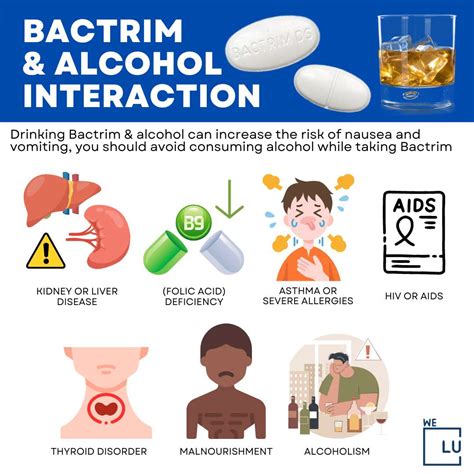Intro
The classification of drugs is crucial for understanding their uses, potential side effects, and interactions. Bactrim, a commonly prescribed antibiotic, falls under a specific drug class that is essential for its application in treating various bacterial infections. To delve into the drug class of Bactrim, it's vital to first understand what Bactrim is and how it works.
Bactrim is a combination antibiotic consisting of two active ingredients: sulfamethoxazole and trimethoprim. It is used to treat a wide range of bacterial infections, including urinary tract infections, bronchitis, traveler's diarrhea, methicillin-resistant Staphylococcus aureus (MRSA) skin infections, and pneumonia. The mechanism of action of Bactrim involves inhibiting the growth and multiplication of bacteria by interfering with the production of folic acid, which is necessary for bacterial DNA synthesis.
Understanding the drug class of Bactrim is essential for healthcare providers to prescribe it appropriately and for patients to understand its potential effects and side effects. The drug class of a medication determines its pharmacological effects, which in turn influence its clinical applications and potential interactions with other drugs.
Bactrim Drug Classification

Bactrim belongs to the class of antimicrobials known as sulfonamides. More specifically, it is classified as a sulfonamide antibiotic because it contains sulfamethoxazole, a sulfonamide derivative. However, its classification can also be extended to the broader category of anti-infective agents due to its use in treating infections. The combination of sulfamethoxazole and trimethoprim in Bactrim enhances its spectrum of activity against bacteria, making it effective against a wide range of gram-positive and gram-negative bacteria.
Working Mechanism of Bactrim

The working mechanism of Bactrim involves the synergistic action of its two components: sulfamethoxazole and trimethoprim. Sulfamethoxazole competes with para-aminobenzoic acid (PABA) for the enzyme dihydropteroate synthetase, which is necessary for the synthesis of folic acid in bacteria. Trimethoprim, on the other hand, inhibits the enzyme dihydrofolate reductase, which is involved in the conversion of dihydrofolic acid to tetrahydrofolic acid, another crucial step in the synthesis of folic acid. By inhibiting these two consecutive steps in the folic acid synthesis pathway, Bactrim effectively prevents the production of folic acid, which is essential for bacterial DNA synthesis and cell division, thereby inhibiting the growth and proliferation of bacteria.
Benefits of Bactrim
The benefits of Bactrim include its broad-spectrum activity against a wide range of bacterial pathogens, its effectiveness in treating various types of infections, and its relatively low cost compared to other antibiotics. Bactrim is particularly useful in treating urinary tract infections, respiratory tract infections, and skin infections caused by MRSA. Its oral formulation makes it convenient for outpatient treatment, reducing the need for hospitalization.Side Effects and Interactions

Like all medications, Bactrim can cause side effects, ranging from mild to severe. Common side effects include nausea, vomiting, diarrhea, and rash. More severe side effects can include Stevens-Johnson syndrome, toxic epidermal necrolysis, and agranulocytosis. Bactrim can also interact with other medications, such as blood thinners, methotrexate, and phenytoin, which may lead to increased risk of side effects or reduced efficacy of either drug.
Precautions and Contraindications
Bactrim is contraindicated in patients with a known hypersensitivity to sulfonamides or trimethoprim, as well as in patients with severe renal impairment. It should be used with caution in patients with liver disease, glucose-6-phosphate dehydrogenase (G6PD) deficiency, and in pregnant or breastfeeding women. Patients taking Bactrim should be advised to stay hydrated, avoid sunlight exposure, and report any signs of allergic reactions or severe side effects to their healthcare provider immediately.Usage and Dosage

The usage and dosage of Bactrim depend on the type and severity of the infection being treated, as well as the patient's age, weight, and renal function. Bactrim is available in oral and intravenous formulations. For adults, the typical dosage for uncomplicated urinary tract infections is 160mg/800mg (trimethoprim/sulfamethoxazole) twice daily for 3 days, while for more complicated infections, the dosage may be increased to 160mg/800mg twice daily for 10 to 14 days. The dosage for children is calculated based on the child's weight.
Resistance and Future Perspectives
The increasing resistance of bacteria to antibiotics, including Bactrim, is a growing concern worldwide. The misuse and overuse of antibiotics contribute to the development of antibiotic-resistant bacteria, which can make infections harder to treat. Future perspectives include the development of new antibiotics and the promotion of responsible antibiotic use through antibiotic stewardship programs.Conclusion and Recommendations

In conclusion, Bactrim is a valuable antibiotic for treating various bacterial infections, thanks to its broad-spectrum activity and synergistic mechanism of action. However, its use must be balanced with the need to combat antibiotic resistance. Healthcare providers should prescribe Bactrim judiciously, and patients should use it responsibly, following the prescribed dosage and duration of treatment. Further research into new antimicrobial agents and strategies to combat resistance is essential for ensuring the continued effectiveness of antibiotics like Bactrim.
What is Bactrim used for?
+Bactrim is used to treat a wide range of bacterial infections, including urinary tract infections, bronchitis, traveler's diarrhea, MRSA skin infections, and pneumonia.
How does Bactrim work?
+Bactrim works by inhibiting the growth and multiplication of bacteria through the synergistic action of sulfamethoxazole and trimethoprim, which interfere with the synthesis of folic acid in bacteria.
What are the common side effects of Bactrim?
+Common side effects of Bactrim include nausea, vomiting, diarrhea, and rash. More severe side effects can include Stevens-Johnson syndrome, toxic epidermal necrolysis, and agranulocytosis.
Can Bactrim be used in pregnant or breastfeeding women?
+Bactrim should be used with caution in pregnant or breastfeeding women, as it can pass into breast milk and may affect the fetus or newborn.
How can antibiotic resistance be combated?
+Antibiotic resistance can be combated through the responsible use of antibiotics, including using them only when necessary, following the prescribed dosage and duration of treatment, and promoting antibiotic stewardship programs.
We invite you to share your thoughts and experiences with Bactrim or any other antibiotic. Your insights can help others understand the importance of responsible antibiotic use and the challenges posed by antibiotic resistance. Please comment below, and don't forget to share this article with anyone who might find it informative and useful. Together, we can work towards a better understanding of antibiotics and their role in treating bacterial infections.
